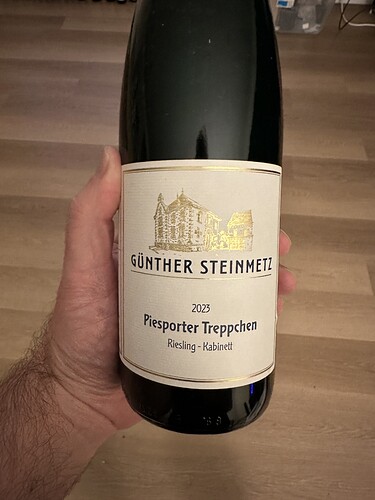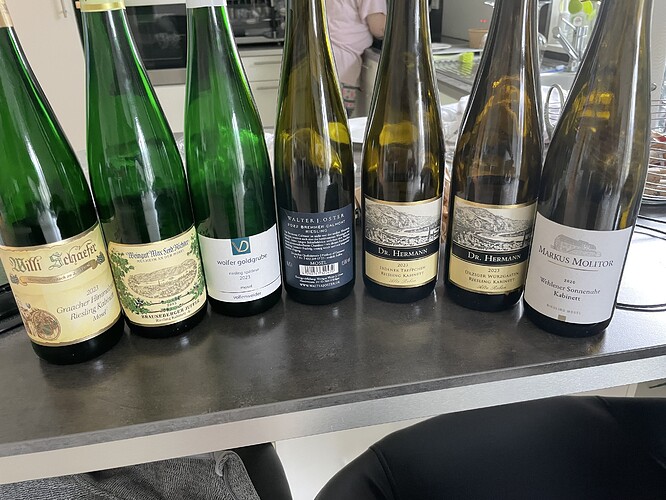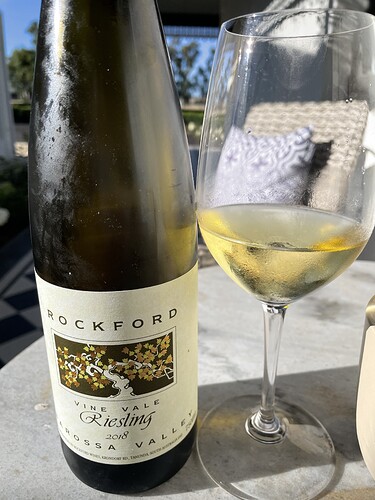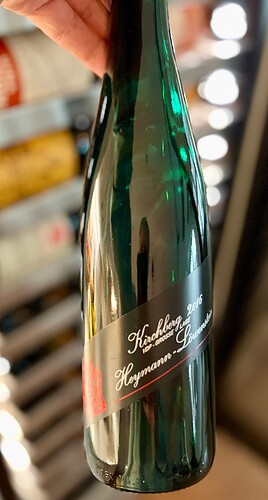The great vintage, quality of producer at the time and proper storage all helped. I do feel that Kabinett Trocken’s do have a weird aging curve and surprise on the upsize at 15-20 years. I have had some 40+ year old Beckers that were stunning.
I can see that. More of the mysterious glory of wine!
Huh. Not my experience at all.
Did you buy that on release?
For a few reasons, I have a pretty hard rule about not buying wine that needs to be shipped to me, but I appreciate the heads-up. ![]()
I get that- was not my expectation. Bought a bunch from Benchmark not too many years ago. Not sure my bottles are totally sound.
2019 Wechsler Westhofener Riesling Trocken
Digging this. Sponti and closed upon opening.
Starts evolving and filling out with time opened (drank over 3 days).
Chalky, salinity, lemon, lime, green apples, herbal. Textural weight and acidic structure really carrying the wine with a zippy vibration. A very long delicious and salivating finish.
2001 Fritz Haag Brauneberger Juffer-Sonnenuhr Riesling Spätlese
The last of my 2 bottles with the previous bottle being opened in 2010. BJS is one of Haags top sites. The highly respected Wilhelm Haag was still in charge of winemaking at the estate in 2001. Wilhelm handed the reigns over to his son Oliver in 2004. Slightly raised cork. A typically very soft cork as well. Light gold color. No petrol aromas. Lovely tropical notes with pears as well. The sweetness was appropriate for a Spatlese. Softer acidity than 14 years ago. Another great 2001 German Riesling which was holding up wonderfully. 95 points.
VM
2002 Gunderloch Nackenheim Rothenberg Riesling Auslese
Opened by a friend who thought the cork looked suspect. 5th time I have had this but not since 2005. Rudi Wiest called this Gunderloch’s “best Auslese ever” when it was released. Light yellow color. The nose was muted at first but this was a wonderfully aged Riesling. Notes of apricots, pineapples and tea. Just about the best showing of the wines I’ve had. Gunderloch makes such nice Rieslings. Hard to go wrong with any of their wines. 95 points.
VM
So often this journey is filled with disappointments. So it’s great when you get surprised on the upside with a bottle like that!
This is my first taste of any ‘23 from Germany. I don’t know if this is representative of the vintage - for Steinmetz, the greater MSR or Germany - but if it is, I may need to vacate my lease and live out of my car for a while, so I can stockpile an epic amount of wine. This opens with a very intense peach note, but any thoughts of opulence were entirely ephemeral, more like a conception of a thought, snuffed out prior to actualization by thunderous, cutting (ripe) acid and a shocking mineral bath. It’s feather light, though with remarkable concentration and intensity. Complex, penetrating, classy, and so refreshing with an exceptionally long finish. If you think a humble Kabinett can’t reach the heights of an Auslese or a Grosses Gewachs, you need to try this. This may outlive me, but I have every intention of drinking all of my 17 remaining bottles in its youthful exuberance with not a single iota of regret. Carpe vinum, mutha f$cker. Carpe Vinum!
I love aged Gunderloch. So underrated.
I really like what I have had from 2023. Need to get on the 23 GGs! BUT I tasted some 2024s and WOW! WOW! WOW! Keep in mind one of those estates was Julian Haart a few of his wines practically had me levitating.
I will agree that the wines we tasted from the 2023 Mosel have been outstanding. I don’t know if it’s my year in and year out experience with drinking Riesling from there or my contrarian view but I never got tied up in vintages per se. To clarify, I adore the differences between each vintages but believe most of these wine makers cannot produce a poor wine for the most part. Take 2014 for example, which we understand to be a horrible year for the region and yeah you don’t get the same portfolio of wines from each producer but what you do get for the most part is great quality wine, if you have done your research on what to buy. I found so many gems from 2014, take the Dr Pauly Bergweiler Urziger Goldwingert Spatlese Auction wine, I’m typically not a buyer of there’s but this wine was just incredible so I stocked up and for the price who wouldn’t have. Another example was with Van Volxem. I’m a fan of there’s and used to buy their wines quite heavily. The Schiefer Riesling which I usually don’t buy really shined this year which was thanks in part to a good amount of de-classified grapes making there way into this wine. I learned this from Mosel Fine Wines publication, went out and bought a bottle, and then went back and bought a case after drinking it. For me the research and tasting are what keeps me intrigued by wine, mainly Mosel Riesling and German Pinot after all of these years.
Based on just a few bottles, I think Max Ferd Richter, who I think has been over performing lately, under performed a bit in 2023. I thought the 2023 Donnhoff Leistenburg Kabinett was great and probably better than an average Leistenburg.
Agree 100%. Tried the lineup from KL and was quite disappointed, compared to the few years prior. Glad I’m not the only one.
Preach!
Did the frost stress make for a better vintage with less grapes?
Frost damage is usually a local phenomenon, so generalisations may be difficult.
As discussed elsewhere on this forum, the Middle Mosel was less affected by the severe frost in mid-April. The Saar and Ruwer, on the other hand, were hit hard and had extensive frost damage. Some growers threw in the towel. But it is true that frost reduces the yield and can result in a higher-quality wine. So much depends on the severity of the frost.
I’ve had some very good HL bottles in the past- this one last night was special: 2016 Weingut Heymann-Löwenstein Hatzenporter Kirchberg. A true Grosses Gewachs. So much power and depth. A precise balance of fruit, acid, minerality, structure, and a leesy, finessed palate. Outstanding. It will outlive me for sure, but pretty damn good now.
From HL:
Facts
Geological definition: Devonian, Ems quartzite. A hard slate with quartzite. The red coloration — iron oxidized into hematite — is an indication of its tropic origins. The sediment accumulated through the entry of fine sands of the Old Red Continent into the primordial ocean. We cultivate one parcel here, totaling 0.5 ha. Orientation: South, elevation 100 - 150 m, slope 100 to 150%, average age of vines: approx. 50 years.
The wines are exclusively vinified with wild yeasts in wooden barrels and absolutely no addition of enzymes or fining agents, and age until summer on the lees. Kirchberg wines are produced dry and bear the designation of VDP.GROSSES GEWÄCHS.




